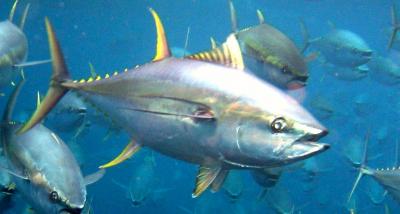A new UC Santa Barbara study shows that threats created by overfishing can be identified decades before the fish species at risk experience high overly harvest rates and subsequent population declines. Researchers developed an Eventual Threat Index (ETI) that quantifies the biological and socioeconomic conditions that eventually cause some fish species to be harvested at unsustainable rates. The findings are published in the Early Edition of the Proceedings of the National Academy of Sciences.
“Overharvesting poses a significant threat to biodiversity, particularly marine biodiversity, where a half-century of industrial fishing has caused the collapse of many populations and severely impacted many ecosystems,” said David Tilman, professor of ecology, biodiversity, and ecosystem functioning at UCSB’s Bren School of Environmental Science & Management and co-author of the paper. Multispecies fisheries, which use trawling, longlining, and seining, are some of the largest contributors and have the most ecological impact.
Previous approaches to defining overfishing mainly inferred threats only after a population had declined or was experiencing high harvest rates. “Though these approaches have provided valuable insights into patterns of overharvesting, they tend to identify already harmed species, said lead author Matthew G. Burgess, an ecology, evolution, and behavior Ph.D. candidate at the University of Minnesota. “The ability to predict future declines can allow us to prevent harm before it has a chance to occur.”
Multispecies fisheries impact many species, so that the long-term fates of all species caught together are linked. Threats to bycatch species are predicted by measuring their harvest rates relative to a few key profitable or managed species whose economic importance makes their long-term harvest rate predictable.
“The key innovation in this approach is the early warning,” said Burgess. “Our method identifies potential future threats right away.”
This approach was tested on eight Pacific tuna and billfish populations, four of which have been identified recently by conventional methods as in decline and threatened with overfishing. The study found that the severe depletion of all four populations could have been predicted in the 1950’s using the ETI.
Even with more recent data, the ETI can point to potential problems. An expanding purse seine fishery in the western Pacific that targets skipjack tuna also catches bigeye and yellowfin tuna. Using data from the 1990’s to the present, ETI calculations predict an eventual threat to yellowfin tuna.
“Right now the yellowfin stock is not being overexploited, but it has undergone a bit of an increase in its decline rate,” said Burgess. “The ETI is telling us that just recently a long-term threat potential for yellowfin tuna has been introduced, and although it hasn’t been realized yet, maybe we should watch out for it.
“Results like these demonstrate that species threatened by human harvesting can be identified much earlier, providing time for adjustments in harvesting practices before consequences become severe and fishery closures or other socioeconomically disruptive interventions are required to protect species,” Burgess said.


